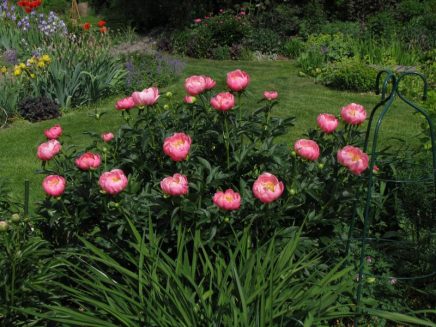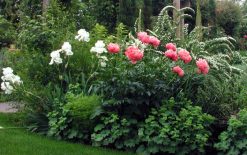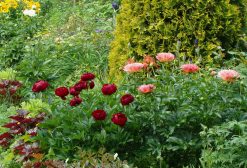A beautifully flowering and very popular plant that can be found in the front garden of an experienced florist is the Coral Sunset peony, which harmoniously combines the characteristics of tree and grass representatives of the genus. For a beginner to get spectacular bushes with large buds, you should first get acquainted with the features of cultivating a rather finicky flower.
Material Content:
Peony Coral Sunset: A Botanical Description of the Variety

Milky-flowered peony “Coral Sunset” is an interspecific hybrid, which is represented by powerful bushes consisting of erect, well-leafy stems. On average, the height of the shoots, the tops of which are crowned with coral flowers, varies within 1 meter. A characteristic feature of the variety is a lighter color in the central part of semi-double inflorescences, which are already observed in June. The duration of flowering is 1-1.5 months.
Agrotechnics growing peonies "Coral Sunset"
In order for decorative bushes to become a decoration of a personal plot, it is necessary to carry out agricultural technology for cultivating crops, which includes planting and peony care activities.
Peony planting
The optimal time for planting seedlings, which is carried out in sunny, sheltered from wind areas with fertile and loose soil, is considered the end of summer, the first half of autumn, when lowering the temperature to 12 ° C contributes to the development of the root system.
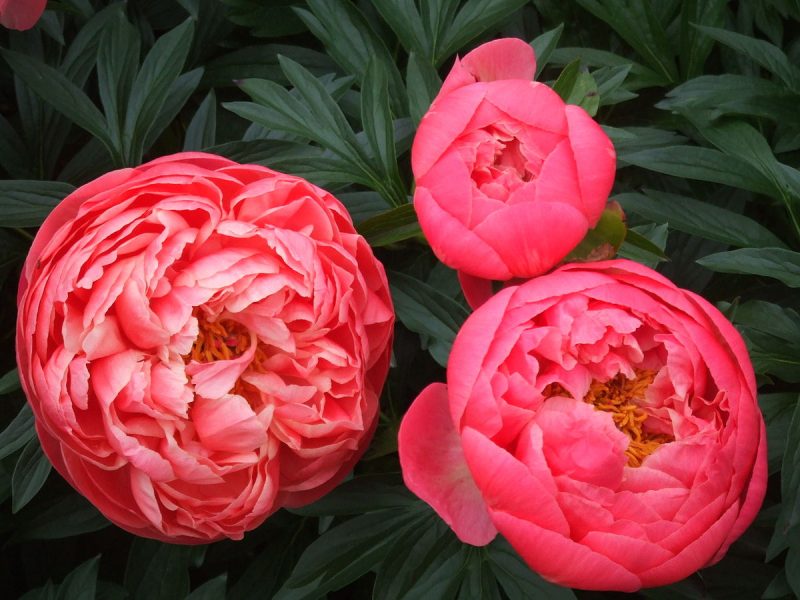
Planting a peony "Coral Sunset" is carried out according to the following scheme:
- Landing pits are dug with a depth of 80 cm and a distance between them of about 1 m.
- A layer of gravel is placed at the bottom to ensure good drainage.
- Then it is poured on sand, peat and organic fertilizers. The composition is mixed.
- A sapling with straightened roots is lowered into the prepared hole and buried in such a way that the root neck is deepened by a maximum of 3 cm.
- A loose mound is formed around the neck, providing free access of air.
- The soil in the near-stem circle is crushed so that there are no air layers near the roots, and watered.
Outdoor Flower Care

A spectacular handsome man needs to be systematically looked after, performing a number of mandatory activities.
- Watering - a water-loving peony needs additional moisture especially during periods of summer drought, when 10-15 liters of water must be poured weekly under each bush. No less important are the moisture reserves in spring during budding and in autumn, when flower buds are laid. For these periods, the required volume is 30 liters of water per instance.
- Loosening and weeding - in spring, soil around the root neck regularly loosens while removing weeds. Also it is imperative to carry out the loosening of the trunk circle after the next wetting.
- Fertilizing and fertilizing - enriching the soil along the perimeter of the trunk circle follows after the peony reaches three years of age. Fertilizing is carried out using complex mineral fertilizers three times per season - in early spring, in the phase of bud formation, after flowering is completed. The consumption rate per bush is 1 tbsp. a spoon of azofoska in a bucket of water.
Breeding

Interspecific hybrids, which include the peony "Coral Sunset" are propagated by dividing the bush, also known as root cuttings:
- Three or four year old bushes with a well-developed root system are selected.
- In late summer and early autumn, the bush is dug up and removed from the ground.
- The rhizome is placed in a shady place so that the soil dries and easily separates.
- The bush is divided into parts, each of which should have 3-4 growth buds and a good root system.
- Places of cuts are processed by crushed wood or activated carbon.
- Delenka is disinfected by placing it in a solution of potassium permanganate for 15 minutes.
- Root cuttings (delenki) are planted in prepared pits, buried and watered abundantly.
- Young specimens are mulched for the winter.
- With the advent of spring, the layer of mulch is removed.
Preparations for the winter
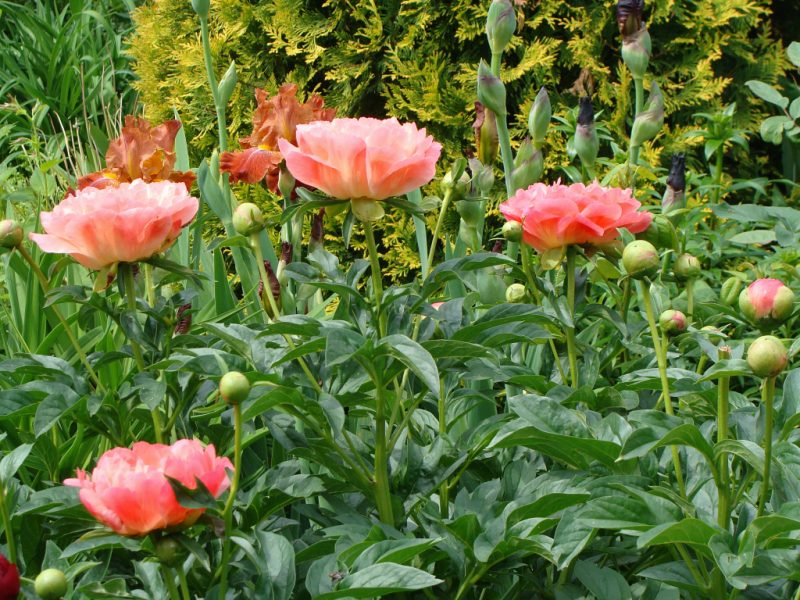
When the flowering is over, phosphorus-potash fertilizers must be applied under the bushes to facilitate the laying of flower buds, which are the key to future lush flowering. After the first frosts, young plants are mulched. Despite the excellent winter hardiness of the variety, it will not be superfluous to cover with a layer of mulch adult bushes that are grown in regions with little snow with severe winters.
Disease and Pest Prevention
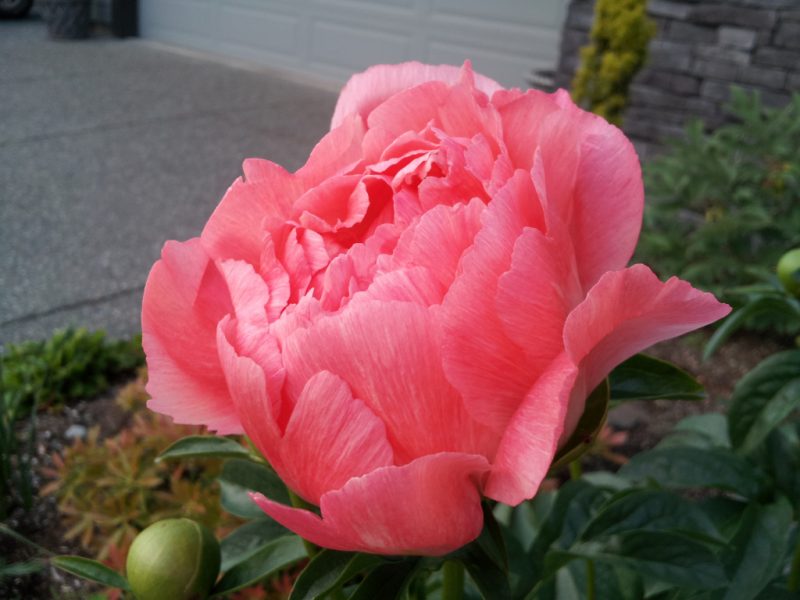
Among the diseases, the foci of which can be noted on peonies, stand out:
- Gray rot is a fungal disease that develops due to excess moisture in the soil. In order to prevent the defeat of peonies by the disease, moderate watering of lush bushes should be carried out. If rot symptoms are detected, immediately remove damaged parts of the shoots and treat the specimens with a fungicide solution.
- Powdery mildew is another fungal disease, the impetus for the development of which is the excessive humidity, typical for rainy spring and summer. If it was not possible to avoid the disease, then similar fungicides are used as for the fight against gray rot.
- Curliness is a viral disease in which leaves become wrinkled and the plant ceases to develop, remaining a dwarf. The disease is practically not treatable, therefore it is more advisable to remove diseased specimens in order to prevent the spread of the virus.
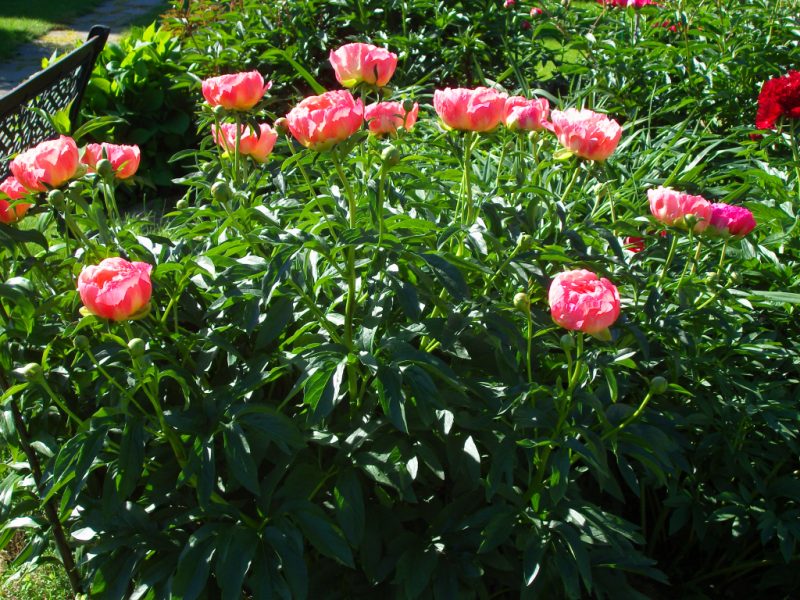
The most dangerous crop pests are:
- Nematodes are worms that affect both the root system of the peony and the aerial part. Bushes populated by nematodes are recommended to be destroyed, and the soil should be watered with a potassium permanganate solution.
- Aphids are microscopic insects that feed on peony shoot juice. Most dangerous are viral diseases carriers. The best preventative measure is compliance with the agricultural technology of cultivating the Peony Coral Sunset
- A spider mite is a sucking pest, which, like aphids, is destroyed by spraying the bushes with an insecticidal preparation.
Peony "Coral Sunset" in landscape design
Grassy peony “Coral Sunset”, which has a rich salmon color, which at the beginning of flowering has a light peach hue, is often used by landscape designers:
- In single plantings, lush bushes with large inflorescences stand out against the background of bright lawns with lush greenery.
- In garden flower and shrub compositions - coral beauties perfectly adjoin to honeysuckle bushes and blue sage.
- In rock gardens - a peony goes well with juniper thickets.
- In border compositions - bushes effectively emphasize the winding garden paths, harmoniously combined with bearded irises.
Thus, if a gardener wants to decorate the garden with coral colors, then the Coral Sunset peony, distinguished by early, long flowering and large inflorescences, is an excellent solution for decorating a personal plot.


